Every spring, just two weeks after the solemn processions of Semana Santa, the city of Seville bursts into a spectacle of color, music, dance, and joy known as La Feria de Abril (The April Fair). It is one of Spain’s most dazzling cultural events — a celebration that captures the very soul of Andalusian life, where tradition and festivity blend in an unforgettable way
Table of Contents
Toggle🌸 Origins of La Feria de Abril
The story of Seville’s April Fair began in 1847, when two local councilors — Narciso Bonaplata, a Catalan, and José María Ybarra, a Basque — proposed holding an annual livestock fair. The event was intended primarily for commerce, but Seville’s natural flair for celebration quickly transformed it into something much more vibrant.
By the 1850s, the fair had become less about trade and more about social gathering, flamenco dancing, and merrymaking. The people of Seville brought their carriages, their horses, and their finest attire, turning what started as a simple cattle market into a glamorous celebration of Andalusian identity.
Over time, the fair evolved into a week-long fiesta featuring casetas (private tents), traditional music, flamenco dresses, and a spirit of joyful elegance that defines Seville to this day
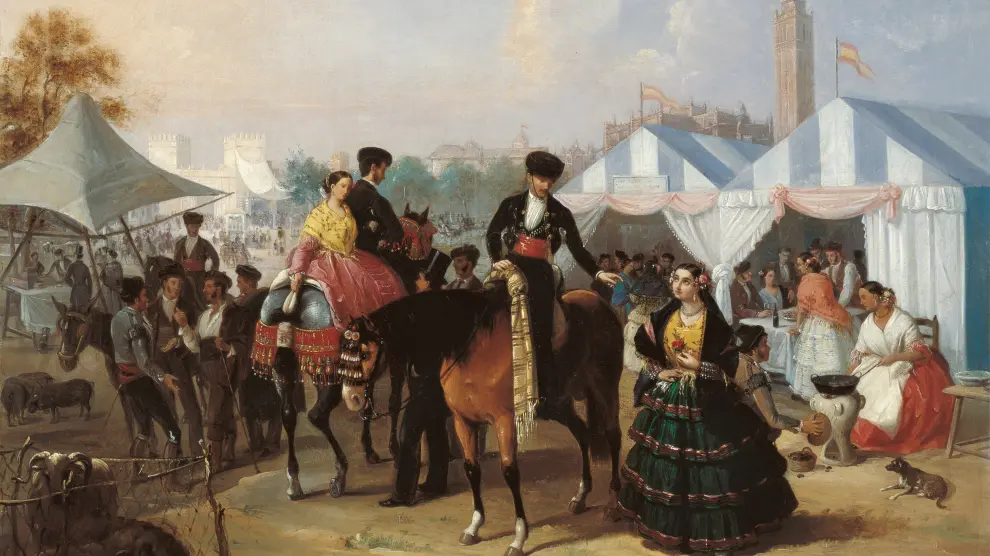
🎪 The Fairgrounds: A Temporary City of Light
La Feria de Abril takes place in a large area called Los Remedios, on the western bank of the Guadalquivir River. Each year, a new main entrance arch (Portada) is designed — a grand structure made of thousands of bulbs and intricate motifs inspired by Seville’s landmarks. When the mayor flips the switch on the Monday night of “La Noche del Pescaito”, the arch and fairgrounds come alive with millions of twinkling lights, signaling the official start of the Feria.
Walking through the fairgrounds feels like entering another world — a temporary city made up of more than 1,000 casetas, each decorated in colorful stripes of red, green, and white. These casetas are where the heart of the celebration beats: families, friends, and associations gather to eat, drink, dance, and sing until the early hours
💃 The Casetas: Heart of the Celebration
Casetas are the private tents that line the fair’s streets. Most belong to families, companies, or organizations, and entry is often by invitation. Inside, visitors find a cozy space filled with Sevillan charm — tables covered with embroidered cloths, lanterns hanging from the ceiling, and live flamenco performances.
However, there are also public casetas managed by the city, where anyone can join the festivities. These open tents are ideal for travelers wanting to experience the magic of the Feria without a private invitation.
Within the casetas, people enjoy traditional Andalusian food such as:
Tortilla española (Spanish omelette)
Jamón ibérico and queso manchego
Gazpacho or salmorejo
Pescaito frito (fried fish)
And, of course, the famous rebujito — a refreshing cocktail made with sherry (manzanilla) and lemon soda, the signature drink of the Feria
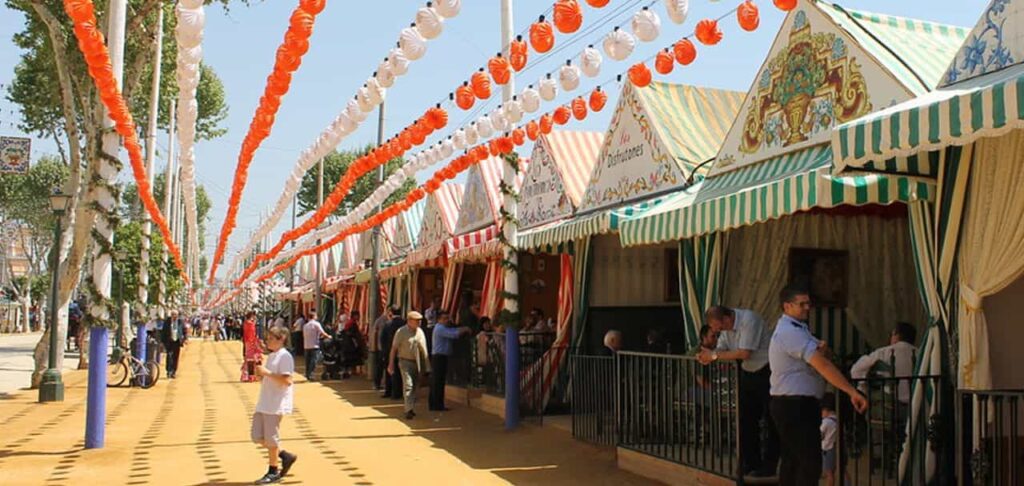
🎶 Music, Dance, and Flamenco Passion
If there is one element that defines La Feria de Abril, it is music — specifically the sevillanas, a joyful form of folk dance and song that originates in Seville.
The rhythm of guitars, castanets, and clapping hands fills the air as couples spin, twirl, and smile in perfect harmony. The dance is structured in four short parts, each telling a story of flirtation and romance, performed with precision and elegance.
Visitors can watch live flamenco shows, join spontaneous dance circles, or simply marvel at the grace of Sevillian dancers who seem to have been born moving to this rhythm. For locals, dancing sevillanas at the Feria is not just entertainment — it is a statement of identity and pride
👗 Traditional Attire: Elegance and Expression
The Feria is also a fashion show in its own right. Women wear the iconic “traje de flamenca” or “traje de gitana” — figure-hugging dresses with cascading ruffles, bright colors, and floral patterns. Each dress is complemented by accessories like flowers in the hair, mantones (shawls), and large earrings.
Men traditionally wear “traje corto”, consisting of high-waisted pants, a short jacket, boots, and a wide-brimmed hat known as a cordobés. Some ride on horseback alongside elegantly dressed women in side-saddle style — a romantic image that perfectly encapsulates the charm of Andalusia.
Fashion trends evolve every year, and designers often unveil their newest flamenco collections just before the Feria. Yet, the essence remains the same: grace, confidence, and color
🐎 Horses, Carriages, and the Daytime Parade
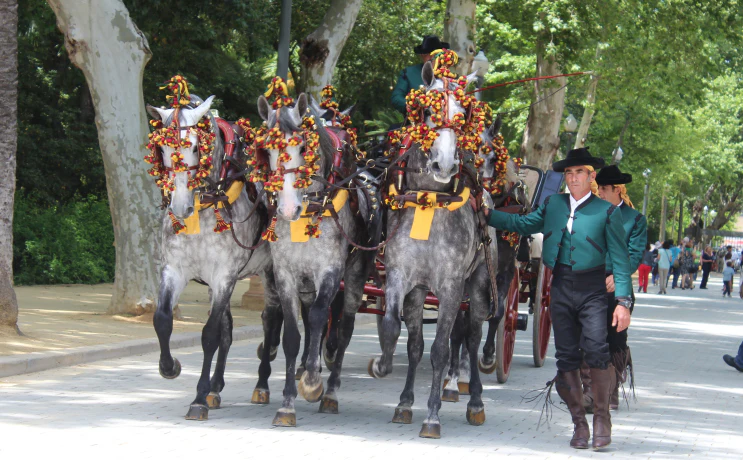
During the day, the Feria transforms into a spectacular parade of horses and carriages. The Paseo de Caballos is one of the highlights — riders in traditional costumes elegantly trotting through the fairgrounds, their horses adorned with colorful ribbons and bells.
This parade showcases Andalusia’s deep equestrian tradition, blending nobility, artistry, and festive charm. Visitors can often hire a carriage ride through the fair, an experience that feels like stepping back in time to 19th-century Sevill
🌅 Nighttime Magic: Lights, Music, and Joy
When the sun sets, La Feria de Abril takes on an entirely new character. The thousands of lights across the Portada and the casetas illuminate the night sky, creating a surreal, dreamlike atmosphere.
Laughter, music, and chatter fill the air as the celebration continues until dawn. Locals and visitors alike dance sevillanas, sip rebujito, and enjoy each other’s company under the warm Andalusian night.
The fairground rides, known as “Calle del Infierno” (Hell Street), add another layer of excitement — with roller coasters, Ferris wheels, and games that keep the fun alive for all ages
🍽️ Flavors of Andalusia: A Culinary Celebration
Beyond the drinks and tapas in the casetas, La Feria de Abril is a culinary showcase of Andalusian gastronomy. Food stalls and local vendors offer irresistible treats:
Churros con chocolate, a perfect late-night snack
Prawns and clams, freshly caught from the Andalusian coast
Paella and montaditos (small sandwiches)
Sweet delights like buñuelos and torrijas
Eating and sharing food is central to the Feria’s spirit — it’s about connection, joy, and savoring life
📅 When and How to Experience the Feria
The Feria usually begins two weeks after Easter (Semana Santa) and lasts for six to seven days, typically from Monday to Sunday. The opening night is called “La Noche del Pescaito”, named after the traditional dinner of fried fish that marks the start of festivities.
The closing night ends with a grand fireworks display over the Guadalquivir River, symbolizing the end of Seville’s spring celebrations.
Tips for Visitors:
Book accommodations early — hotels fill up months in advance.
Wear comfortable shoes — you’ll walk and dance a lot!
Visit during the daytime to see the horses and carriages, then stay for the evening lights.
Try the rebujito — but pace yourself; it’s stronger than it tastes!
Don’t worry if you don’t have access to a private caseta — the public ones are full of life and open arms.
Learn a few sevillanas steps before you go — locals appreciate visitors who join the dance
🕊️ A Celebration of Andalusian Spirit
What makes La Feria de Abril so special isn’t just its beauty or scale, but its sense of belonging and joy. It’s a week when time seems to stop, and Seville becomes a living postcard of its own culture — full of laughter, pride, music, and color.
Whether you come to dance, eat, admire the dresses, or simply absorb the atmosphere, the Feria offers something magical for everyone. It is, without doubt, one of Spain’s most authentic and soul-stirring experiences — a festival where Andalusia’s heart beats the loudest
✨ Final Thoughts
La Feria de Abril is more than just a festival; it is a living expression of Seville’s identity, rooted in tradition yet forever vibrant. Each year, it renews the city’s spirit, reminding locals and visitors alike of the joy of community, the beauty of heritage, and the art of celebration.
So, if you ever find yourself in Spain in the springtime, don’t miss Seville’s April Fair. Come ready to dance, to smile, to taste, and to fall in love — not just with the festival, but with the Andalusian way of life
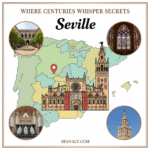
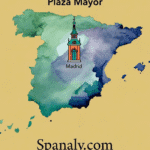
[…] La Feria de Abril – Seville’s Iconic Spring Fair Carnival in Santa Cruz de Tenerife: Spain’s Spectacle Las Fallas Festival: Valencia on Fire […]